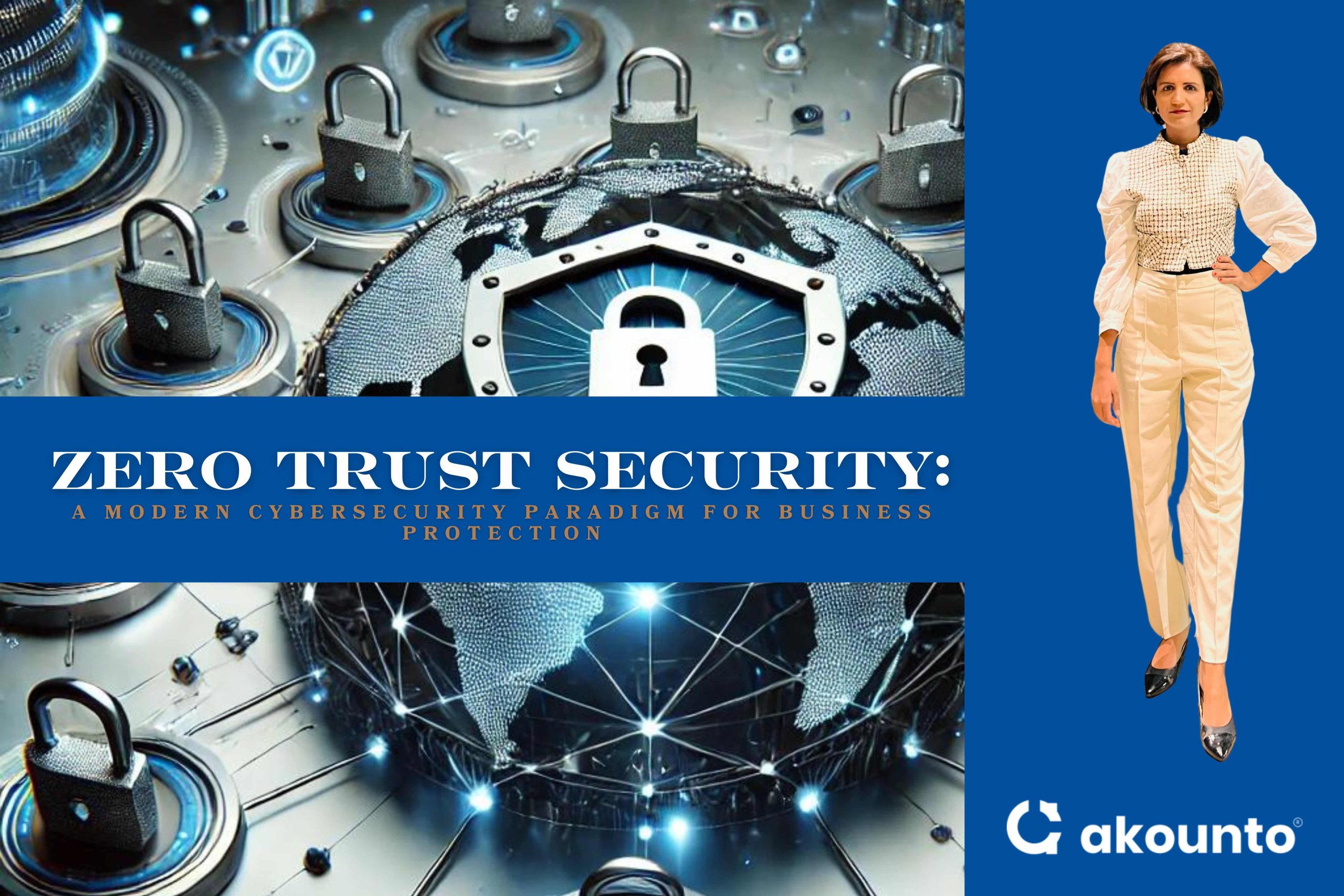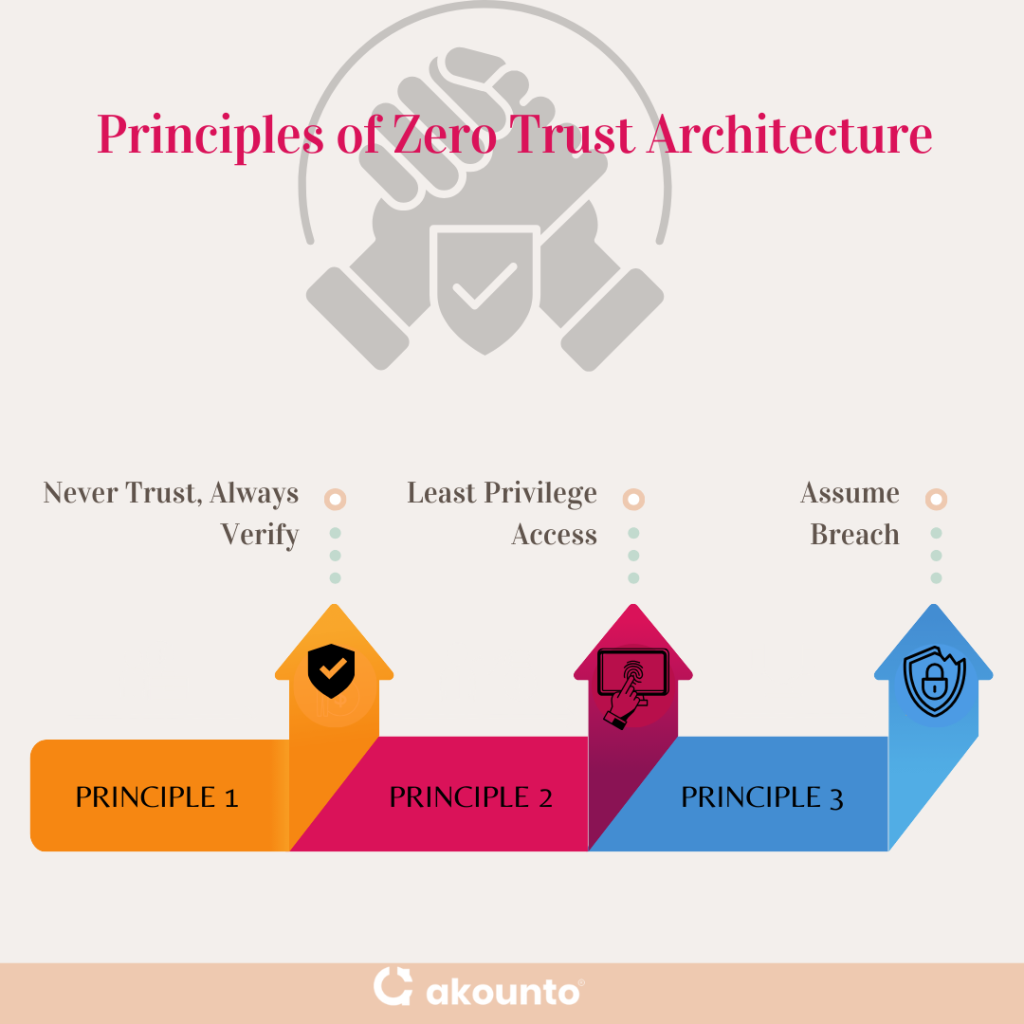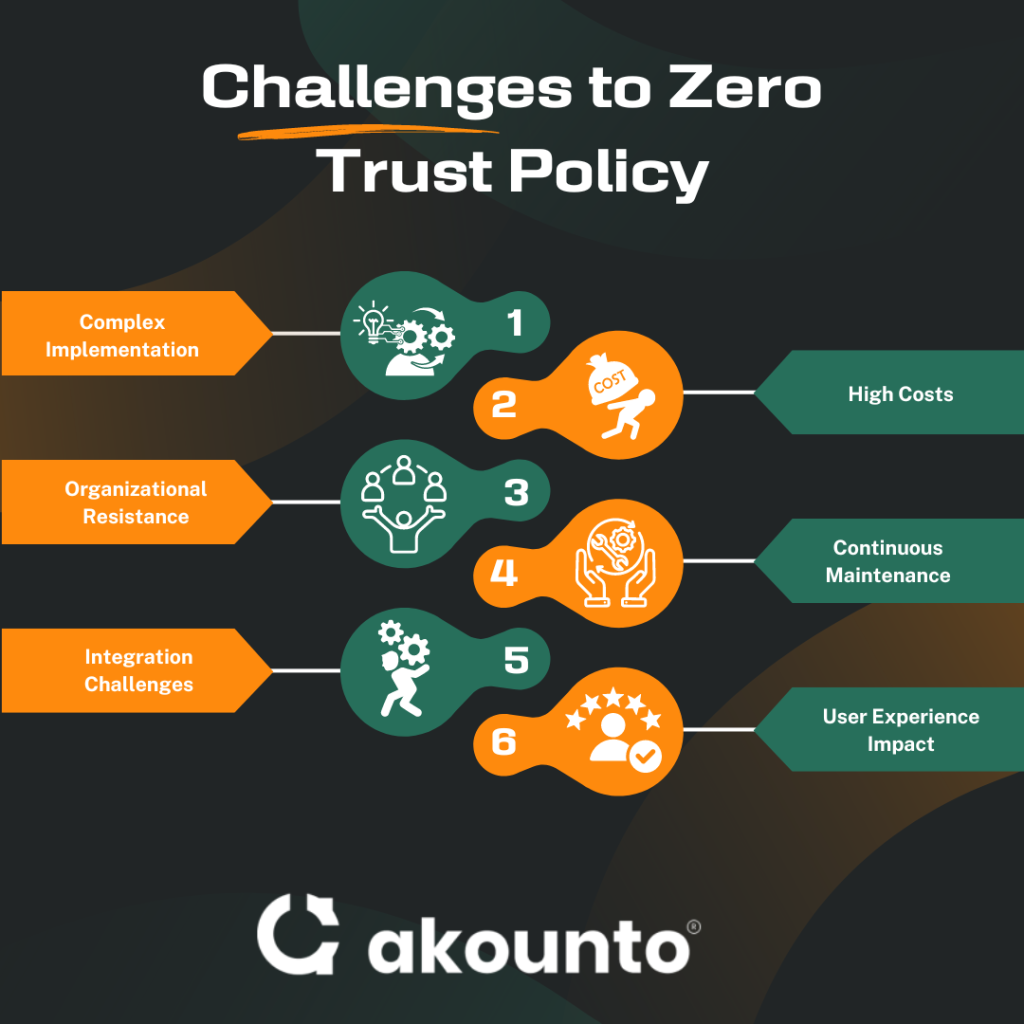Zero Trust Security: A Modern Cybersecurity Paradigm for BusinessProtection

Zero Trust Security: A Modern Cybersecurity Paradigm for BusinessProtection
What is Zero Trust in Cybersecurity?
Zero Trust Architecture, also known as Zero Trust Security, is a cybersecurity paradigm that adopts an end-to-end approach to secure all entities, endpoints, credentials, access management systems, networks, and hosting environments.
Traditional security models assume entities inside the network are trustworthy.
Zero Trust assumes no implicit trust and requires continuous verification of users and devices at every access point.
Google, through its BeyondCorp model, is a prominent example of a company implementing Zero Trust architecture. BeyondCorp eliminates traditional network perimeters, enabling secure access for employees from any location without using a VPN. This transformation has helped Google scale its security across diverse environments.
Trust is also highly beneficial in SaaS environments, where applications reside outside traditional network boundaries. With the growing integration of AI and machine learning, Zero Trust allows for real-time monitoring, anomaly detection, and automated security responses. These technologies enhance the Zero Trust model by continuously adapting to evolving threats.
Trusted Internet Connections (TIC) initiative emerged as a vital part of Zero Trust. TIC 3.0, for instance, updates network security principles to account for cloud services, remote work, and modern device management. This approach aligns with Zero Trust by focusing on securing each connection and verifying users regardless of network location.
What is Perimeterless Security in the Zero Trust Model?
Perimeter in traditional cybersecurity consisted of a boundary of a network protected by firewalls, intrusion detection, VPNs, etc. Core idea was to keep the threats out of the perimeter and consider anyone or anything inside as trustworthy.
Perimeterless security in the Zero Trust model, completely discards this boundary, especially with the rise of cloud computing, remote work, mobile devices, and SaaS applications, there is no longer a clear distinction between internal and external networks.
Zero Trust acknowledges that every part of the network is vulnerable, regardless of its physical location. Therefore, security is applied to each individual user, device, and data access point—independent of location—requiring verification at every step.
The shift from a trust-based cybersecurity system to a trustless model is driven by the increasing sophistication of cyber threats and the changing nature of modern work environments.
In traditional systems, once an attacker breached the perimeter, they could move freely within the network, exploiting the inherent trust of internal entities. Zero Trust eliminates this vulnerability by assuming every network interaction could be malicious, prompting continuous verification of identity and intent.
For businesses, a perimeterless, trustless cybersecurity system offers several advantage:
- It reduces the risk of internal threats by ensuring every action within the network is verified
- Provides businesses with stronger security for remote employees
- Allows seamless integration with cloud platforms
- Offers better protection for sensitive data
- Continuous monitoring and AI-enhanced detection help to identify suspicious activity in real time
- Offers dynamic responses to emerging threats
Need and Importance of Zero Trust Architecture
Evolving Cyber Threats
The 2023 IBM Cost of a Data Breach Report revealed that the average global cost of a data breach reached $4.45 million per incident, with threats such as ransomware and phishing being among the most common attack vectors. In 2022, the number of ransomware attacks alone increased by 13%, more than in the past five years combined.
Traditional security models, which rely on perimeter defenses, often fail to prevent attackers from moving laterally within a network once the perimeter is breached. For example, in the Target data breach of 2013, attackers gained access through a third-party vendor, bypassing the company’s firewall and compromising over 40 million customer records. This breach exemplified how internal trust within a network can be exploited.
Zero Trust Architecture (ZTA) eliminates implicit trust and requires continuous verification of every user, device, and network interaction. This proactive approach minimizes the damage from a single point of failure, making it more effective against sophisticated and persistent cyber threats.
Regulatory and Compliance Requirements
As organizations handle increasing amounts of sensitive data, regulatory frameworks such as GDPR (General Data Protection Regulation) in Europe and HIPAA (Health Insurance Portability and Accountability Act) in the U.S. have set strict requirements for data protection and access control. Non-compliance can result in severe financial penalties, legal consequences, and reputational damage. For instance, under GDPR, companies can face fines up to €20 million or 4% of annual global turnover, whichever is higher.
Zero Trust helps businesses comply with these regulations by implementing continuous access management, which ensures that only authorized personnel have access to protected data. This model enforces least privilege access, meaning users are granted only the minimum access necessary for their roles. It also facilitates encryption and multi-factor authentication (MFA), which are critical elements in ensuring the confidentiality and integrity of sensitive information, as required by regulatory standards.
Zero Trust's robust auditing and real-time monitoring help maintain ongoing compliance by providing detailed logs of who accessed data and when.
Limitations of Traditional Approaches to Cybersecurity
- Implicit Trust Assumptions: Traditional cybersecurity models trust users, devices, and entities inside the network, assuming they are safe. Once the perimeter is breached, attackers can move freely within the system, increasing the risk of lateral attacks.
- Perimeter-Based Defenses: Traditional security focuses on securing the network perimeter using firewalls, VPNs, and intrusion detection systems. However, modern cloud environments, remote workforces, and mobile devices make it impossible to define a single, secure perimeter..
- Lack of Continuous Authentication: Traditional systems rely on initial authentication at the point of entry. After this, users and devices are often not re-verified, allowing attackers to exploit this gap if they gain unauthorized access.
- Vulnerable to Insider Threats: Insider threats are difficult to detect in traditional models, as trusted entities inside the network are granted broad access to resources. Attackers can exploit this implicit trust to escalate privileges and steal data.
- Limited Visibility and Monitoring: Traditional models typically do not offer comprehensive visibility into user behavior and device activity after initial login. This makes it harder to detect anomalies in real-time, especially with advanced persistent threats (APTs).
- Static Access Controls: Traditional cybersecurity relies on static access control lists (ACLs) and rules, which are not adaptable to dynamic environments. As a result, they cannot quickly adjust to changing conditions or emerging threats.
- Inadequate Protection for Cloud and Remote Environments: As businesses move to cloud-based services and adopt remote work models, traditional security tools, which are designed for on-premises infrastructure, fail to secure these distributed environments.
Principles of Zero Trust Architecture

Never Trust, Always Verify
The core principle of Zero Trust is continuous verification. Unlike traditional models that trust users inside the network, Zero Trust assumes that every access request, whether internal or external, could be a threat. This approach mandates that every request be verified in real-time before access is granted.
Multi-Factor Authentication (MFA) plays a critical role in this process. By requiring multiple forms of verification, such as a password combined with a biometric factor or a one-time code, MFA significantly reduces the chances of unauthorized access.
Behavioral analytics adds another layer of security by monitoring patterns like user behavior, location, and device usage. Any deviations from normal behavior can trigger further verification or alert security teams. This continuous scrutiny ensures that access is granted only after the identity, device, and context have been thoroughly verified.
Least Privilege Access
The principle of least privilege access ensures that users and devices are only granted the minimum level of access required to perform their tasks. This reduces the potential attack surface, as attackers who compromise an account will have limited access to resources.
Role-Based Access Control (RBAC) is often employed in Zero Trust architectures to enforce least privilege. RBAC assigns users access rights based on their roles within the organization. For example, a finance employee will only have access to financial data, not unrelated resources like HR records.
Just-in-Time (JIT) access, where users are given temporary access to specific resources for a limited time. Once their task is completed, the access is automatically revoked, further reducing security risks.
Assume Breach
The assume breach principle acknowledges that no system is completely immune to attacks. Instead of focusing solely on preventing breaches, Zero Trust operates under the assumption that a breach has already occurred or will eventually happen. This mindset shifts the focus to limiting the damage caused by breaches.
By compartmentalizing resources and continuously verifying access, Zero Trust limits the movement of attackers within the network. Even if one segment is compromised, other parts of the system remain secure. Additionally, network segmentation and real-time monitoring ensure that any suspicious activity is detected and addressed quickly, minimizing the overall impact of an attack.
“At Akounto Financial Inc, the management embraced Zero Trust Architecture to ensure that every transaction, login, and data access is rigorously verified. This approach not only safeguards our clients’ financial data but also enables us to stay agile, compliant with evolving regulations, and resilient against increasingly sophisticated cyber threats. Zero Trust is more than a cybersecurity measure—it's a commitment to protecting the future of financial services."
Soniya Malik - Founder & CEO, Akounto Financial Inc
Pillars of Zero Trust Security Model
Identity Verification
A core pillar of the Zero Trust model is strong identity verification, which ensures that only authenticated users can access sensitive resources. Traditional username-password systems are no longer sufficient in preventing breaches. Zero Trust reinforces this with Multi-Factor Authentication (MFA), requiring users to provide at least two forms of identification, such as passwords and biometrics (fingerprints, facial recognition).
For higher security, organizations often adopt biometrics like fingerprint scans or retina recognition to strengthen identity verification. This approach not only safeguards against stolen credentials but also minimizes unauthorized access attempts, as biometric data is much harder to replicate or steal. By tying authentication to verified user identities, Zero Trust drastically reduces the risk of impersonation or compromised accounts.
Device Security
Zero Trust treats every device, whether internal or external, as untrusted until validated. In this model, access is not granted based solely on user authentication; the security posture of the device must also be verified.
Endpoint Detection and Response (EDR) tools play a significant role in ensuring device security. EDR continuously monitors devices for signs of suspicious behavior, ensuring that only those complying with organizational security policies (e.g., up-to-date software and patches) are allowed to access network resources. Even corporate devices must undergo regular health checks before access is granted, ensuring that compromised devices are quickly isolated.
Network Segmentation
Micro-segmentation is another key pillar, which helps isolate critical assets and limit the movement of attackers within the network. In traditional networks, once an attacker breaches the perimeter, they can move laterally across the system, compromising multiple resources. Micro-segmentation breaks the network into smaller, more secure segments.
This approach ensures that access to each segment is granted based on strict verification policies, limiting exposure if one part of the network is compromised. It significantly reduces the ability of attackers to navigate the system, preventing them from accessing more sensitive areas after an initial breach.
Data Protection
Data encryption is crucial for securing sensitive information, both at rest and in transit. Encryption ensures that even if data is intercepted or accessed by unauthorized users, it remains unreadable. In Zero Trust, encryption is applied at all stages, from internal communications to external data transfers.
Data Loss Prevention (DLP) tools are also critical for monitoring and controlling data movement across the network. DLP technologies prevent unauthorized access to sensitive data, ensuring that information cannot be leaked, copied, or exfiltrated without detection. By applying these methods, Zero Trust strengthens the protection of high-value assets against data breaches.
Visibility and Analytics
Zero Trust operates on the principle of real-time monitoring and analytics. Continuous tracking of user behavior and device activity is vital to detect suspicious patterns or anomalies, such as unusual login times or access from unfamiliar locations.
Using advanced analytics and machine learning, Zero Trust systems can detect potential threats in real-time, providing actionable insights that help mitigate risks. This visibility ensures that organizations are aware of who is accessing what, when, and from where, making it easier to respond to any signs of compromise swiftly.
Benefits of Zero Trust Policy in Cybersecurity
- Enhanced Security Posture: By continuously verifying users, devices, and access requests, Zero Trust minimizes the risk of unauthorized access and breaches, providing a more proactive defense against evolving cyber threats.
- Minimized Attack Surface: With strict access control policies like least privilege and micro-segmentation, Zero Trust limits the potential entry points for attackers, reducing the overall attack surface of the network.
- Improved Visibility and Monitoring: Zero Trust policies involve real-time monitoring and behavioral analytics, enabling organizations to detect and respond to anomalies and threats in real time.
- Stronger Compliance: By enforcing continuous access management and data protection policies, Zero Trust helps organizations meet regulatory requirements such as GDPR, HIPAA, and PCI DSS, reducing the risk of non-compliance penalties.
- Support for Remote Work: As remote work and cloud adoption grow, Zero Trust ensures secure access for employees regardless of their location, enhancing security without compromising productivity.
- Flexibility and Scalability: Zero Trust is adaptable to dynamic environments like cloud platforms, hybrid networks, and mobile devices, making it suitable for modern enterprise architectures
Challenges to Zero Trust Policy

- Complex Implementation: Implementing Zero Trust requires significant changes to an organization’s existing infrastructure, making the transition complex and time-consuming, especially in legacy systems.
- High Costs: Deploying the necessary tools (e.g., EDR, MFA, and micro-segmentation) and re-architecting networks for Zero Trust can be costly, particularly for small and mid-sized businesses.
- Organizational Resistance: Moving from traditional trust models to a Zero Trust framework often meets resistance from employees and management, who may find the new processes more rigid or invasive.
- Continuous Maintenance: Zero Trust requires ongoing monitoring, regular updates to policies, and revalidation of devices and users. This increases operational overhead for IT and security teams.
- Integration Challenges: Integrating Zero Trust solutions with existing tools and applications can be difficult, particularly when dealing with diverse environments like hybrid clouds and third-party applications.
- User Experience Impact: With constant reauthentication and verification processes, Zero Trust can lead to user friction, affecting productivity and user satisfaction if not balanced with usability considerations
Use Case: Zero Trust Network Access (ZTNA)
ZTNA vs. Traditional VPN
Zero Trust Network Access (ZTNA) offers more granular, secure access to specific resources compared to traditional Virtual Private Networks (VPNs). Traditional VPNs provide broad access to the entire network once a user is authenticated, which increases the risk if an attacker gains access to the VPN. The attacker could potentially move laterally across the network, targeting sensitive resources.
In contrast, ZTNA operates on the principle of least privilege access. Instead of granting wide network access, ZTNA restricts access to only the specific applications or resources that a user needs to perform their tasks. Each access request is subject to continuous verification, ensuring that users and devices are validated for every session. This minimizes the attack surface by limiting the areas of the network that can be accessed, offering a much more controlled and secure environment.
How ZTNA Works
ZTNA secures access by creating secure tunnels between the user and the requested resource, authenticating each session individually. When a user attempts to access a resource, ZTNA first checks their identity using methods like Multi-Factor Authentication (MFA) and verifies the security posture of their device through tools like Endpoint Detection and Response (EDR). Once verified, ZTNA establishes a secure, encrypted tunnel that allows the user to interact with only the specific resource they are authorized for.
Throughout the session, ZTNA continuously monitors activity and can revoke access immediately if suspicious behavior is detected. This ensures that security is dynamic, adapting to real-time threats, and enhancing overall network protection.
Zero Trust is not just a cybersecurity strategy—it's a business imperative
The traditional approach to security relies on a perimeter defense, where anything inside the network is trusted. However, with remote work, cloud applications, and mobile devices now the norm, this model is outdated.
Zero Trust assumes that no one and nothing can be trusted without continuous verification, offering more targeted and proactive protection for your business assets. This ensures that only the right people have access to the right data, reducing the risk of internal and external breaches.
For a business owner, this shift to Zero Trust offers clear, tangible benefits:
- Reduced Risk of Data Breaches: With ZTA’s continuous verification and least-privilege access policies, you minimize the chance of unauthorized users or compromised devices accessing your sensitive business information.
- Cost Efficiency: The average cost of a data breach in 2023 was $4.45 million. Preventing these breaches through a Zero Trust mindset saves your business from the potentially crippling financial fallout of a cyberattack.
- Enhanced Regulatory Compliance: Zero Trust helps ensure your business meets industry regulations like GDPR and HIPAA, protecting you from non-compliance fines and boosting your credibility.
- Flexibility and Scalability: As your business grows or adopts new technologies, Zero Trust adapts to changing conditions, providing security across remote work setups, cloud environments, and evolving business needs.
How to Make and Implement Zero Trust Policy
Creating a Zero Trust Policy involves several critical steps that ensure every part of your network, data, and system interactions are secure.
Step 1: Assess Your Current Security Posture
Begin by evaluating your current security infrastructure. Identify weaknesses in your existing perimeter-based security model and pinpoint sensitive assets, user roles, devices, and applications that require protection. Use this assessment to understand how data flows across your network, including cloud environments, on-premises systems, and remote work setups.
Step 2: Define Trust Boundaries and Critical Resources
Zero Trust relies on clearly defined access controls around critical business data and systems. Identify and classify these resources, and create strict access boundaries. This could include customer databases, intellectual property, financial data, and operational systems. Once identified, you can start assigning levels of trust and access requirements for users and devices.
Step 3: Implement Identity and Access Management (IAM)
The core of Zero Trust is ensuring that every user and device is authenticated before accessing the network. Implement strong Identity and Access Management (IAM) practices, such as Multi-Factor Authentication (MFA) and Single Sign-On (SSO), to verify user identities. Additionally, adopt Role-Based Access Control (RBAC) to limit access based on the specific needs of each user, ensuring they only have access to the data and systems necessary for their role.
Step 4: Establish Least Privilege Access
Apply the principle of least privilege access throughout your network, granting users and devices the minimum permissions they need to perform their tasks. Tools like Just-in-Time (JIT) access can further limit access, ensuring it is temporary and only granted when necessary.
Step 5: Utilize Continuous Monitoring and Analytics
Zero Trust requires ongoing monitoring of network activity to detect and respond to threats. Deploy Endpoint Detection and Response (EDR) and Security Information and Event Management (SIEM) tools to monitor device activity and user behavior. Implement real-time analytics to track anomalies and suspicious behavior, which helps in identifying potential threats before they cause damage.
Step 6: Network Segmentation
Segment your network into micro-perimeters to prevent attackers from moving laterally if they gain access to one part of the system. Use micro-segmentation to isolate critical systems and sensitive data, allowing more granular control of user access within the network.
Step 7: Automate Security Policies
Automate access control and security responses wherever possible. By leveraging machine learning and automation tools, you can ensure that policies are enforced consistently across the network without human intervention. Automation also helps reduce errors and improves response times when potential threats are detected.
Step 8: Educate and Train Employees
A key part of Zero Trust is ensuring that employees understand the importance of security and follow the defined policies. Conduct regular security training sessions, especially on topics like phishing, password hygiene, and the proper use of multi-factor authentication.
Step 9: Implement Zero Trust in Phases
Start with a pilot project, applying Zero Trust principles to a specific application or department. Gradually scale up to the entire organization, ensuring smooth integration and minimizing disruptions. Continuous evaluation of the policy’s effectiveness will allow you to adjust it as the business evolves.
Conclusion
Zero Trust Security offers a transformative approach to cybersecurity, especially for modern businesses operating in cloud environments, remote work settings, and dealing with increasing cyber threats.
Implementing Zero Trust Architecture (ZTA) is not just about boosting security—it’s about safeguarding the future of your business in a practical, scalable way.




